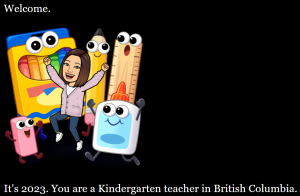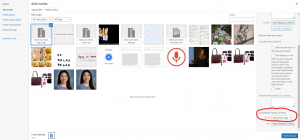Twine:
Elaine Lee_Twine Story (This should take you to a page where you need to click on the .zip file to download).

Overview of Elaine’s Twine Task
I have seen others use Twine in my other MET courses, yet I have never played with it.
I decided to write about a day in the life of a kindergarten teacher…and I went for it without a draft. After creating the story paths, I was determined to add images to this Twine as the example, The Temple of No provided in our task. I looked up YouTube tutorials and found one by John Fry (2017). I created a Bitmoji avatar, downloaded images to my laptop, and uploaded them to postimages.com to get a direct link for each of the photos. I felt tech-savvy typing <img src=(insert direct link here)> onto Twine and felt a sense of accomplishment as the images pop up in the dark background.
During the process of creating Twine, I was so worried to lose my creation. Even after downloading, I kept the browser open and didn’t turn my laptop off for three days! Once I have completed the story component, I proofread my work, organized the paths, and ran it 10 more times. I enjoyed this first attempt with Twine and can see the benefits of using Twine in a Language Arts classroom. It allows viewers to actively participate and engage in choosing their own adventure and feel a sense of authority as their decisions follow with direct outcomes. This related back to Bolter’s (2001) reading this week, “In following hypertextual links, the reader becomes conscious of the form or medium itself ” (p.43).
Interestingly, the most challenging part of this assignment was uploading it!? To be honest, I panicked a little when I see that the final project is downloaded as an HTML file. And, I was right – I searched on Google and watched numerous YouTube videos, and all attempts led to this…
Then I came to realize that there were a few options for story formats – next, I tried using Github to ‘package’ Twine and attempted posting it directly to WordPress. Nope…
Eventually, I decided to reach out to Ernesto and take a break to freshen up. I was ready to go through this again later in the evening. New progress, it was showing up as a . Zip file on WordPress! However, when I clicked on it, nothing happened. I figured I will play around with all the options under the attachment details and VOILA! Two learning curves in one week!
References
Bolter, Jay David. (2001). Writing space: computers, hypertext, and the remediation of print. New York, NY: Routledge.
Frank, A. (2016, June 20). Crows Crows Crows’ new game is the most fun 10 minutes you’ll have today Links to an external site.. Polygon.
Fry, J. (2017, March 27). Twine – Adding Pictures [Video]. Youtube. https://www.youtube.com/watch?v=DRETz9wnOkk



Elaine,
This was HILARIOUS and also very stressful, especially since I teach high school and struggle with totally different things on my day to day. I’m not going to lie…. your job seems a lot harder than mine does… I go pee whenever I need (although I suppose a lot of trust comes with that). I truly could not imagine having to hold it… all I see is a million UTIs, no thanks. I appreciate that some of your pages didn’t have options – it is actually super realistic to a teaching day, sometimes you truly don’t have a choice. I also enjoyed your addition of images as it kept me super interested. I found it very entertaining that you used a bitmoji of yourself to show different emotions – I was riding that emotional roller coaster with you.
I also struggled with uploading my twine and chose to upload it to a third party game site and embed it that way on my page. I also found googling different code was really helpful and allowed me to change colours and fonts as well as embed gifs! I have now started using Twine in my Grade 8 Information Technology/Robotics class as an assignment and my students love it. I did make a coding cheat sheet as I understand (from personal experience) how frustrating it can get to test code until it works.
I really enjoyed the quote you chose by Bolter (2001), “in following hypertextual links, the reader becomes conscious of the form or medium itself ” (p.43). I think by adding hypertext links it forces the audience to engage. In order to make an informed decision, critical thinking must take place. Instead of being passive consumers of media it allows us to engage actively with it.
Jessie